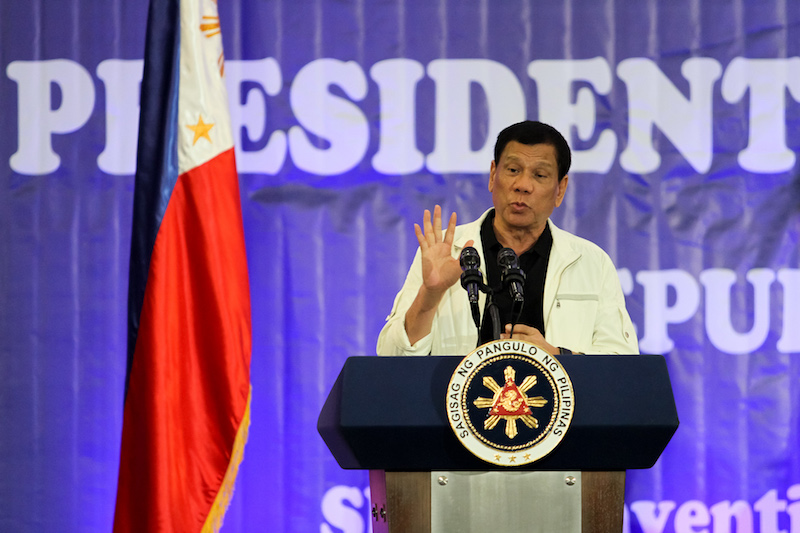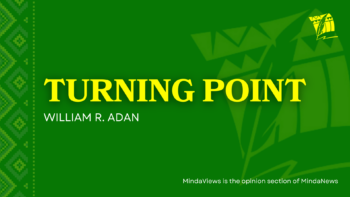DAVAO CITY (MindaNews /11 March) — A Davao City-based group has asked President Rodrigo Duterte, the country’s first Dabawenyo and Mindanawon President, to “desist from making further pronouncements about declaring Martial Law” and “immediately account,” instead, for the results of the now six-month old “State of National Emergency on account of lawless violence in Mindanao.”
In a statement dated March 11, Konsyensya Dabaw, a multisectoral group set up in August 2016 to protest the burial of the dictator Ferdinand Marcos, Sr. at the Libingan ng mga Bayani also challenged the public to “be vigilant and not complacently accept machinations to create scenarios of violence and ‘trouble in Mindanao’ … spinning out of control.”
 President Rodrigo Duterte warns he would place Mindanao under martial law if governors and mayors do not help him. Duterte met with some 240 governors and mayors from 13 of Mindanao’s 27 provinces at the SMX Convention Center in Davao City on 09 March 2017. MindaNews photo by MANMAN DEJETO
President Rodrigo Duterte warns he would place Mindanao under martial law if governors and mayors do not help him. Duterte met with some 240 governors and mayors from 13 of Mindanao’s 27 provinces at the SMX Convention Center in Davao City on 09 March 2017. MindaNews photo by MANMAN DEJETO
Duterte on Thursday night told governors and mayors from 12 of 27 Mindanao provinces that he would place Mindanao under martial law if they do not help him prevent violence from “spinning out of control.”
The first Mindanawon President “can certainly do better than consign Mindanao to another dark period by declaring Martial Law, whether in our area or including the rest of the country,” Konsyensya Dabaw said in a statement released by Mags Maglana, titled “Martial Law: not in the name of Mindanao and Mindanawons.”
.The Philippine Statistics Authority estimates the population of Mindanao as of 2015 at 24 million, spread across 27 provinces and 33 cities.
Warina Sushil Bint Ismuraji, Western Mindanao coordinator of the Philippine Alliance of Human Rights Advocates (PAHRA), said “more than 824,000 civilians are in the 19 municipalities of my homeland, Lupah Sug they call Sulu. (Twenty four) million people are in Mindanao. How many are lawless elements? A handful?”
“Why must (24) million civilians suffer under martial law just because of a handful rascals?” Warina asked.
In Marawi City, Drieza Liningding, chair of the Moro Consensus Group, said the President, “instead of issuing warnings of declaring martial law, should focus on his plan for system change.”
“The shift from unitary to federal set up will help address the conflicts in Mindanao including drugs and terrorism. So why waste lives and money if we have a better and bloodless alternative?” asked Liningding, a supporter of Duterte.
“Quick-fix solution”
Duterte on September 5 issued Proclamation 55, directing the Armed Forces of the Philippines and the Philippine National Police to “undertake such measures as may be permitted by the Constitution and existing laws to suppress any and all forms of lawless violence in Mindanao and to prevent such lawless violence from spreading and escalating elsewhere in the Philippines, with due regard to the fundamental civil and political rights of our citizens.”
READ: From “lockdown” to “state of lawlessness” to “state of national emergency”
The Proclamation was issued a day after a bomb exploded at the Roxas night market in Davao City that left 15 persons dead and 69 others injured.
Duterte has not lifted the proclamation.
Konsyensa Dabaw urged local government officials in Mindanao not to endorse martial law as a “quick-fix solution” to Mindanao’s problems.
It said the best help local officials can give to the national leadership is “to do your job well with all the resources that have been afforded you by law.”
“We, your fellow Mindanawons, are prepared to help you as we move towards the Mindanao of our hopes without using the means that will only make Mindanao more troubled, and Mindanawons traumatized and fearful,” it said.
No to martial law
Maguindanao Governor Esmael Mangudadatu and Lanao del Sur Vice Governor Mamintal Adiong, Jr., told MindaNews Thursday night that they do not want the President to declare martial law. Mangudadatu said governors and mayors should heed Duterte’s plea and exert efforts to prevent violence in their areas. “Nagpapatulong yung matanda eh. Di nya kaya” (The old man is asking our help. He can’t do it by himself).
READ: Duterte warns of martial law if governors, mayors don’t help him
Zamboanga City Mayor Maria Isabelle Climaco-Salazar told MindaNews the President’s threat to declare martial law was “just an appeal to really help fight terrorism and fight criminality because Mindanao is suffering.”
She said she does not want martial law, having experienced its difficulties. Her uncle, Cesar Climaco, openly defied the Marcos dictatorship when he was mayor of Zamboanga City, and was assassinated in November 1984.
Adiong said no one in the Autonomous Region in Muslim Mindanao (ARMM) wants martial law.
READ: Duterte as mayor proposed martial law in MIndanao in 2003
He said he hopes the President would visit each province so he can interact with officials and discuss the problems. “Yung dialogue talaga sa probinsya” (A dialogue in the province), Adiong said as he lamented why there was no open forum during the meeting. Duterte arrived at the SMX Convention Center at 5:48 p.m., spoke for 58 minutes, posed for souvenir photos then left the hall.
Mindanao card
Konsyensa Dabaw said the Marcos dictatorship cited rebellion in Mindanao as among its justifications to declare martial law.
Marcos issued Proclamation 1081 on September 21, 1972, placing the entire country under martial law. Konsyensya Dabaw noted that the proclamation cited Mindanao at least 13 times, “associated with the terms ‘lawlessness,’ ‘fear and panic,’ ‘chaos and disorder,’ ‘armed clashes, killings, massacres, arsons, rapes, pillages, destruction of whole villages and towns and the inevitable cessation of agricultural and industrial operations, and state of actual war.”
The Proclamation named conflict actors in Mindanao such as the New Peoples Army, “conflict between certain elements of the Christian and Muslim population,” “between the Christian ‘Ilagas’ and the Muslim ‘Barracudas’,” and “between our government troops, and certain lawless organizations such as the Mindanao Independence Movement,” reinforcing “simplistic and reductionist views of these.”
Konsyensya Dabaw stressed that Martial law did not make things better but worse for Mindanao and that Marcosian policies facilitated the entry of big domestic and foreign business interests “that took advantage of the forest, mineral, agricultural, and marine resources of Mindanao” and in a number of cases, “business colluded with the military and police to drive out communities.”
The statement recalled how Marcos allied with Mindanao’s elite “who rapidly armed themselves to the teeth, and amassed more wealth and power, even if it meant terrorizing and exploiting their own populations.”
The problems in Mindanao that Marcos cited to justify martial law — from “lawlessness” to “state of actual war” — became more commonplace under Martial Law, creating conditions for heightened unrest as more groups rose to protest injustices and fight the dictatorship.
Nationwide, Mindanao suffered the most number of human rights violations under the Marcos dictatorship.
But it was also among the first to fight martial rule and in the last years of the Marcos dictatorship, mounted Mindanao-wide Welgang Bayans (People’s Strike) that paralyzed transportation and economic activities.
Konsensya Dabaw said Mindanao became even more neglected and its development more stunted when Marcos and his cronies sought to funnel government resources to areas that they controlled.
“We were the cash cow that got peanuts. The violent and frontier image that Marcos had cultivated to warrant the continuation of authoritarian rule made Mindanao unattractive to more sustainable economic activities,” it added.
It also pointed out that “much of the contemporary discrimination against Mindanao and Mindanawons — that we had neither electricity nor airports, that Muslims were by nature scheming, and that indigenous peoples and the rest of the population were unshod and ignorant — could be traced back to the time of Martial Law, when Mindanao was written off as unsafe, and its peoples became more misunderstood.”
Konsyensa Dabaw also stressed that while Mindanao faced many challenges and conflicts even before Martial Law, “their resolution can only come from an understanding of complexities and the historical nature of problems.”
“It is this understanding of ‘historical injustices’ that we expect the President to display and demonstrate,” it said.
Duterte has repeatedly vowed to address historical injustices committed against the Moro people and the national government’s neglect of Mindanao. (Carolyn O. Arguillas / MindaNews)
